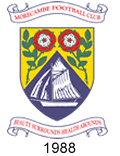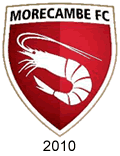Morecambe
The Lancashire seaside town of Morecambe is more famous for its extensive views over the desolate sands of Morecambe Bay than it is for football. A number of attempts had been made to establish an association football club in the area but in the early part of the 20th century without success. In May 1920, Morecambe FC was formed and immediately admitted to the Lancashire Combination. A few years later, thanks to the generosity of their president, JB Christie, the club acquired a new home named after their patron, Christie Park.
Poor results in the Combination and the indifference of the local community meant that the club was in a constant battle for survival. After the Second World War, “The Shrimps” gradually consolidated, appearing in the FA Cup third round in 1960 and in 1974, they won the FA Trophy at Wembley.
constant battle for survival. After the Second World War, “The Shrimps” gradually consolidated, appearing in the FA Cup third round in 1960 and in 1974, they won the FA Trophy at Wembley.
Despite home attendances which had dropped from an average of 2,000 to less than 200, the club persevered and was eventually rewarded with a place in the new Northern Premier League in 1968.
In 1995 Morecambe won promotion to the Alliance Premier League, the competition that evolved into the Conference. Here they were moderately successful until finishing in third place in 2006-07 to qualify for the play-offs.
In May 2007 thousands of “Sand Grown Uns” followed the club to the new Wembley Stadium to witness the Conference play-off final against Exeter City, a match they won 2-1 and with that, promotion to the Football League.
Conference play-off final against Exeter City, a match they won 2-1 and with that, promotion to the Football League.
At the end of the 2009-10 season, in which they reached the play-offs, Morecambe quit Christie Park and moved into the brand new Globe Arena in July 2010. As is now customary on such occasions, a new crest was introduced to replace the municipal coat of arms worn since 1988. The choice of a shrimp as the central feature was chosen to represent the team's traditional nickname.
